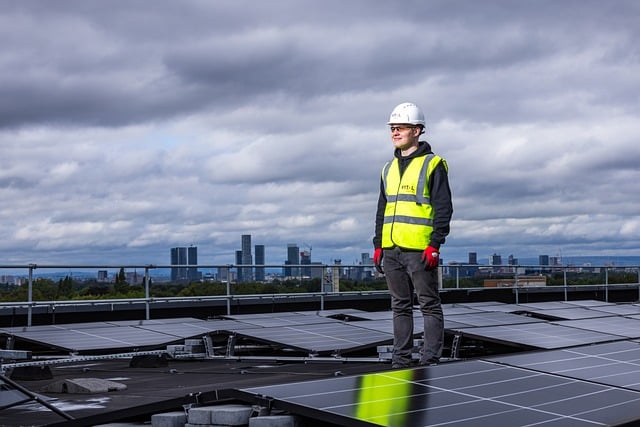“Unlocking Solar Potential: Discover the Benefits of Every Inverter Type!”
The increasing adoption of solar energy has led to the development of various types of solar inverters, each offering unique advantages tailored to different applications and needs. Understanding the benefits of these inverter types is crucial for optimizing solar energy systems, enhancing efficiency, and maximizing return on investment. This exploration delves into the distinct characteristics of string inverters, microinverters, and power optimizers, highlighting their respective strengths in terms of performance, installation flexibility, and system monitoring. By examining these differences, consumers and installers can make informed decisions that align with their energy goals and environmental aspirations.
Advantages of String Inverters for Residential Solar Systems
When considering the installation of a residential solar system, one of the most critical components to evaluate is the solar inverter. Among the various types available, string inverters have emerged as a popular choice for homeowners. Their design and functionality offer several advantages that make them particularly well-suited for residential applications. Understanding these benefits can help homeowners make informed decisions about their solar energy systems.
One of the primary advantages of string inverters is their simplicity and cost-effectiveness. String inverters connect multiple solar panels in a series, or “string,” allowing them to share a single inverter. This configuration not only reduces the overall installation costs but also simplifies the system design. With fewer components involved, string inverters are generally easier to install and maintain compared to more complex systems, such as microinverters or power optimizers. This straightforward approach can be particularly appealing for homeowners looking to minimize upfront expenses while still reaping the benefits of solar energy.
In addition to their cost advantages, string inverters are known for their reliability and durability. These inverters have been in use for many years and have a proven track record in various climates and conditions. Their robust design means they can withstand the elements, making them a dependable choice for residential installations. Furthermore, many manufacturers offer warranties that can last up to 10 to 12 years, providing homeowners with peace of mind regarding their investment.
Another significant benefit of string inverters is their efficiency in converting solar energy into usable electricity. While they may not perform as well as microinverters in situations where shading is a concern, string inverters are highly efficient under optimal conditions. They typically have high conversion efficiencies, often exceeding 95%, which means that a greater percentage of the solar energy captured by the panels is converted into electricity for household use. This efficiency can lead to substantial savings on energy bills over time, making string inverters an attractive option for many homeowners.
Moreover, string inverters are equipped with advanced monitoring capabilities. Many modern string inverters come with built-in monitoring systems that allow homeowners to track their energy production in real-time. This feature not only helps users understand their energy consumption patterns but also enables them to identify any potential issues with their solar system quickly. By having access to this data, homeowners can take proactive measures to ensure their system operates at peak performance, further enhancing the overall benefits of their solar investment.
Additionally, string inverters are compatible with various solar panel configurations, making them versatile for different residential setups. Whether a homeowner has a small rooftop system or a larger ground-mounted array, string inverters can be adapted to meet specific energy needs. This flexibility allows homeowners to customize their solar systems according to their unique circumstances, ensuring they get the most out of their investment.
In conclusion, string inverters offer numerous advantages for residential solar systems, including cost-effectiveness, reliability, efficiency, advanced monitoring capabilities, and compatibility with various configurations. As homeowners increasingly seek sustainable energy solutions, understanding the benefits of string inverters can empower them to make informed choices that align with their energy goals. By selecting the right inverter type, homeowners can maximize their solar energy production and enjoy the long-term financial and environmental benefits that come with harnessing the power of the sun.
Benefits of Microinverters in Maximizing Energy Production

Microinverters have emerged as a pivotal technology in the solar energy landscape, offering distinct advantages that significantly enhance energy production. Unlike traditional string inverters, which connect multiple solar panels in series, microinverters are installed on each individual panel. This unique configuration allows for optimized performance, particularly in scenarios where shading, orientation, or panel mismatch may otherwise hinder energy generation. By converting direct current (DC) to alternating current (AC) at the panel level, microinverters ensure that each solar module operates at its maximum potential, thereby maximizing overall energy output.
One of the primary benefits of microinverters is their ability to mitigate the effects of shading. In a string inverter system, if one panel is shaded, it can reduce the performance of the entire string, leading to significant energy losses. In contrast, microinverters allow each panel to function independently. This means that even if one panel is partially shaded by a tree or a nearby structure, the other panels can continue to operate at their optimal capacity. As a result, homeowners can enjoy a more consistent and reliable energy production throughout the day, regardless of environmental conditions.
Moreover, microinverters enhance energy production through their superior performance in low-light conditions. Traditional string inverters may struggle to convert energy efficiently when sunlight is limited, but microinverters excel in these situations. By optimizing the output of each panel individually, they can capture more energy during dawn, dusk, and cloudy days. This capability is particularly beneficial for regions that experience variable weather patterns, as it allows homeowners to maximize their energy harvest year-round.
In addition to improving energy production, microinverters also offer enhanced monitoring capabilities. Each microinverter can be equipped with monitoring technology that provides real-time data on the performance of individual panels. This level of granularity allows homeowners to identify underperforming panels quickly and address any issues that may arise. Whether it’s a malfunctioning panel or a buildup of debris, having the ability to monitor each panel’s performance ensures that the solar system operates efficiently and effectively. This proactive approach to maintenance can lead to increased energy production and, ultimately, greater savings on electricity bills.
Furthermore, the installation of microinverters can lead to increased system longevity. Since microinverters are designed to operate at lower temperatures and are less susceptible to the wear and tear associated with high-voltage systems, they often have longer lifespans compared to traditional string inverters. This durability translates into lower maintenance costs and a more reliable energy source over time. Homeowners can rest assured that their investment in solar technology will continue to pay dividends for years to come.
Lastly, microinverters provide flexibility for future system expansions. As energy needs grow or as technology advances, homeowners may wish to add more solar panels to their existing systems. With microinverters, this process is straightforward, as each new panel can be added independently without the need to reconfigure the entire system. This adaptability not only simplifies the expansion process but also allows homeowners to scale their solar energy production according to their evolving needs.
In conclusion, the benefits of microinverters in maximizing energy production are clear. From their ability to mitigate shading effects and enhance performance in low-light conditions to their advanced monitoring capabilities and increased longevity, microinverters represent a compelling choice for homeowners looking to optimize their solar energy systems. As the demand for renewable energy continues to grow, understanding the advantages of different solar inverter types, particularly microinverters, will empower consumers to make informed decisions that align with their energy goals.
Exploring Power Optimizers: Enhancing Efficiency in Solar Arrays
In the realm of solar energy, the efficiency of solar arrays is paramount, and one of the key components that can significantly enhance this efficiency is the power optimizer. Power optimizers are devices that are installed on each solar panel, allowing for individual panel performance monitoring and optimization. This technology has gained traction in recent years, as it addresses some of the common challenges associated with traditional solar inverter systems, particularly in terms of shading, orientation, and varying panel performance.
One of the primary benefits of power optimizers is their ability to mitigate the effects of shading. In a conventional solar array, if one panel is shaded, it can reduce the overall output of the entire system due to the series connection of the panels. However, power optimizers allow each panel to operate independently, meaning that even if one panel is partially shaded, the others can continue to perform at their optimal levels. This capability is particularly advantageous in residential settings where trees, buildings, or other obstructions may cast shadows on certain panels at different times of the day.
Moreover, power optimizers enhance energy harvest by maximizing the output of each individual panel. This is achieved through a process known as maximum power point tracking (MPPT), which ensures that each panel operates at its peak efficiency regardless of the conditions. By continuously adjusting to changes in sunlight and temperature, power optimizers can extract more energy from the solar array compared to traditional systems that rely on a single inverter to manage the entire array. As a result, homeowners and businesses can enjoy increased energy production, leading to greater savings on electricity bills and a faster return on investment.
In addition to improving energy output, power optimizers also facilitate better monitoring and diagnostics of solar systems. With the ability to track the performance of each panel individually, system owners can quickly identify any issues that may arise, such as a malfunctioning panel or a drop in performance due to dirt or debris. This level of monitoring not only helps in maintaining optimal performance but also extends the lifespan of the solar array by allowing for timely maintenance and repairs.
Furthermore, the installation of power optimizers can enhance the overall design flexibility of solar systems. Since each panel operates independently, installers have more freedom in arranging panels in various orientations and configurations. This flexibility is particularly beneficial for rooftops with complex layouts or for ground-mounted systems where space may be limited. As a result, power optimizers can help maximize the use of available space while ensuring that the solar array remains efficient and effective.
In conclusion, power optimizers represent a significant advancement in solar technology, offering numerous benefits that enhance the efficiency and performance of solar arrays. By addressing issues related to shading, maximizing energy harvest, providing detailed monitoring capabilities, and allowing for greater design flexibility, power optimizers are becoming an increasingly popular choice for both residential and commercial solar installations. As the demand for renewable energy continues to grow, understanding and leveraging the advantages of power optimizers will be essential for optimizing solar energy systems and achieving sustainable energy goals. With their ability to improve overall system performance, power optimizers are undoubtedly a valuable addition to the solar energy landscape.
The Role of Central Inverters in Large-Scale Solar Installations
In the realm of large-scale solar installations, central inverters play a pivotal role in optimizing energy production and ensuring the efficient operation of solar power systems. These inverters serve as the heart of solar farms, converting the direct current (DC) generated by solar panels into alternating current (AC), which is essential for integration into the electrical grid. One of the primary benefits of central inverters is their ability to manage large arrays of solar panels, making them particularly suitable for utility-scale projects. By consolidating the conversion process, central inverters can handle significant amounts of power, often exceeding several megawatts, which is crucial for meeting the energy demands of large facilities or communities.
Moreover, central inverters are designed with advanced technology that enhances their efficiency and reliability. They typically feature sophisticated maximum power point tracking (MPPT) algorithms, which optimize the energy harvest from solar panels by adjusting to varying sunlight conditions throughout the day. This capability is especially important in large installations where shading from nearby structures or trees can impact performance. By maximizing energy capture, central inverters contribute to the overall productivity of solar farms, ensuring that they generate as much electricity as possible.
In addition to their efficiency, central inverters offer a streamlined approach to maintenance and monitoring. With a centralized system, operators can easily access performance data and conduct troubleshooting from a single point, reducing the complexity associated with managing multiple smaller inverters. This centralized monitoring capability not only simplifies maintenance but also enhances the reliability of the solar installation. Operators can quickly identify and address issues, minimizing downtime and ensuring that the system operates at peak performance.
Another significant advantage of central inverters is their cost-effectiveness in large-scale applications. While the initial investment may be higher compared to smaller inverter systems, the economies of scale achieved through centralization often lead to lower overall costs per watt. This is particularly beneficial for developers and investors looking to maximize returns on their solar projects. Additionally, central inverters typically have longer lifespans and lower replacement costs, further contributing to their financial viability in large installations.
However, it is essential to acknowledge that central inverters are not without their limitations. For instance, if a single inverter experiences a failure, it can impact the performance of the entire solar array, leading to potential energy losses. This risk underscores the importance of robust design and redundancy measures in large-scale solar projects. Despite this drawback, advancements in technology continue to enhance the reliability of central inverters, making them a preferred choice for many utility-scale applications.
As the demand for renewable energy sources grows, the role of central inverters in large-scale solar installations becomes increasingly critical. Their ability to efficiently convert and manage substantial amounts of energy, coupled with their cost-effectiveness and ease of maintenance, positions them as a cornerstone of modern solar power systems. In conclusion, while there are various inverter types available, central inverters remain a dominant force in the solar industry, driving the transition towards a more sustainable energy future. As technology continues to evolve, the benefits of central inverters will likely expand, further solidifying their importance in the landscape of renewable energy.
Q&A
1. **Question:** What are the main types of solar inverters?
**Answer:** The main types of solar inverters are string inverters, microinverters, and power optimizers.
2. **Question:** What is a key benefit of using microinverters?
**Answer:** Microinverters allow for individual panel optimization, improving energy production in shaded or unevenly lit conditions.
3. **Question:** How do power optimizers enhance solar energy systems?
**Answer:** Power optimizers maximize the output of each solar panel while still using a central inverter, improving overall system efficiency.
4. **Question:** What advantage do string inverters offer for residential solar systems?
**Answer:** String inverters are typically more cost-effective and easier to install, making them a popular choice for residential applications.
Conclusion
In conclusion, exploring the benefits of different solar inverter types reveals that each type—string inverters, microinverters, and power optimizers—offers unique advantages tailored to specific installation needs and conditions. String inverters are cost-effective and suitable for simpler systems, while microinverters provide enhanced performance and monitoring for complex or shaded environments. Power optimizers combine features of both, allowing for improved energy harvest and system flexibility. Understanding these differences enables consumers and installers to make informed decisions that maximize energy efficiency, system reliability, and overall return on investment in solar energy systems.



